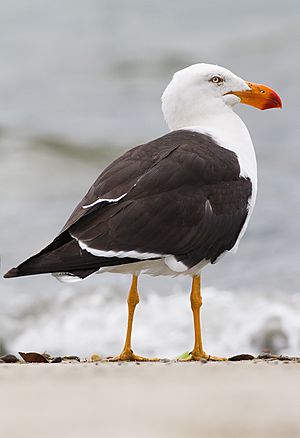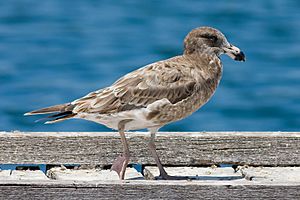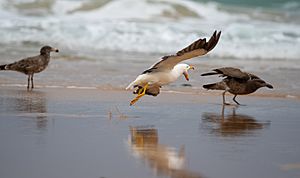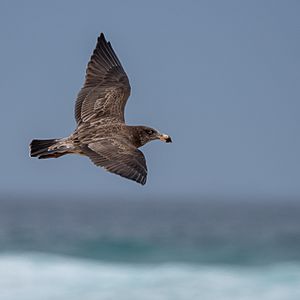Pacific gull facts for kids
Quick facts for kids Pacific gull |
|
|---|---|
 |
|
| Larus pacificus pacificus Adventure Bay, Tasmania, Australia | |
| Conservation status | |
| Scientific classification | |
| Genus: |
Larus
|
| Species: |
pacificus
|
| Subspecies | |
|
L. p. pacificus Latham, 1801 |
|
The Pacific gull (Larus pacificus) is a very large gull that lives along the coasts of Australia. You can often spot them from Carnarvon in the west to Sydney in the east. However, they have become less common in some southern areas. This is partly because of the kelp gull, which arrived in Australia around the 1940s and competes with the Pacific gull for food and space.
Pacific gulls are much bigger than the common silver gull. You usually see them alone or in pairs. They might be resting on the shore, flying slowly over the water, or even soaring high to drop a shellfish or sea urchin onto rocks to break them open for a meal!
Contents
About the Pacific Gull
The Pacific gull was first officially described in 1801 by an English bird expert named John Latham. He used a drawing by Thomas Watling to help him. The name pacificus refers to the Pacific Ocean.
There are two main types, or subspecies, of Pacific gull:
- L. p. pacificus: This type lives along the south-east coast of Australia and in Tasmania.
- L. p. georgii: This type is found in South Australia and Western Australia.
What Does a Pacific Gull Look Like?
Pacific gulls are the only really big gulls in Australia, besides the kelp gull. They can grow to be about 58 to 66 centimeters (23 to 26 inches) long. Their wings can spread out from 137 to 157 centimeters (54 to 62 inches) wide! They usually weigh between 900 and 1180 grams (2 to 2.6 pounds).
Most of their body is white, but their wings and back are dark. They have a very thick, strong yellow beak with a bright red tip. Like many seabirds, they have special glands that help them get rid of extra salt from the salty water they drink or eat. This salty water comes out through their nostrils.
Young Pacific gulls look quite different from adults. They are mottled brown all over. It takes them a few years to get their adult feathers. By the time they are four years old, it's hard to tell a young bird from a fully grown one.
Where Do Pacific Gulls Live and How Do They Reproduce?
The eastern type of Pacific gull (L. p. pacificus) prefers calm, sheltered beaches. However, the western type (L. p. georgii) can often be found even on shores that are exposed to strong winds and waves.
Both types of Pacific gulls build their nests in pairs or in small groups on islands off the coast. They make a cup-shaped nest from grasses and sticks in an open spot. Female gulls usually lay two or three mottled brown eggs.
See also
 In Spanish: Gaviota del Pacífico para niños
In Spanish: Gaviota del Pacífico para niños





